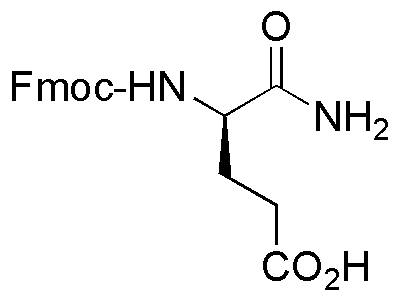Fmoc-D-glutamic acid a-amide is widely utilized in research focused on:
- Peptide Synthesis: This compound serves as a key building block in the synthesis of peptides, particularly in solid-phase peptide synthesis, allowing for the creation of complex peptide sequences with high purity.
- Drug Development: It plays a crucial role in the pharmaceutical industry for developing peptide-based drugs, enhancing the stability and bioavailability of therapeutic agents.
- Bioconjugation: Researchers use it for bioconjugation processes, linking peptides to other biomolecules, which is essential in creating targeted drug delivery systems.
- Research in Neuroscience: The compound is valuable in studying neurotransmitter functions and developing neuroprotective agents, contributing to advancements in treating neurological disorders.
- Protein Engineering: It is employed in the modification of proteins to improve their properties, such as solubility and stability, which is vital in various biotechnological applications.
General Information
Properties
Safety and Regulations
Applications
Fmoc-D-glutamic acid a-amide is widely utilized in research focused on:
- Peptide Synthesis: This compound serves as a key building block in the synthesis of peptides, particularly in solid-phase peptide synthesis, allowing for the creation of complex peptide sequences with high purity.
- Drug Development: It plays a crucial role in the pharmaceutical industry for developing peptide-based drugs, enhancing the stability and bioavailability of therapeutic agents.
- Bioconjugation: Researchers use it for bioconjugation processes, linking peptides to other biomolecules, which is essential in creating targeted drug delivery systems.
- Research in Neuroscience: The compound is valuable in studying neurotransmitter functions and developing neuroprotective agents, contributing to advancements in treating neurological disorders.
- Protein Engineering: It is employed in the modification of proteins to improve their properties, such as solubility and stability, which is vital in various biotechnological applications.
Documents
Safety Data Sheets (SDS)
The SDS provides comprehensive safety information on handling, storage, and disposal of the product.
Product Specification (PS)
The PS provides a comprehensive breakdown of the product’s properties, including chemical composition, physical state, purity, and storage requirements. It also details acceptable quality ranges and the product's intended applications.
Certificates of Analysis (COA)
Search for Certificates of Analysis (COA) by entering the products Lot Number. Lot and Batch Numbers can be found on a product’s label following the words ‘Lot’ or ‘Batch’.
Numéro de catalogue
Numéro de lot/série
Certificates Of Origin (COO)
This COO confirms the country where the product was manufactured, and also details the materials and components used in it and whether it is derived from natural, synthetic, or other specific sources. This certificate may be required for customs, trade, and regulatory compliance.
Numéro de catalogue
Numéro de lot/série
Safety Data Sheets (SDS)
The SDS provides comprehensive safety information on handling, storage, and disposal of the product.
DownloadProduct Specification (PS)
The PS provides a comprehensive breakdown of the product’s properties, including chemical composition, physical state, purity, and storage requirements. It also details acceptable quality ranges and the product's intended applications.
DownloadCertificates of Analysis (COA)
Search for Certificates of Analysis (COA) by entering the products Lot Number. Lot and Batch Numbers can be found on a product’s label following the words ‘Lot’ or ‘Batch’.
Numéro de catalogue
Numéro de lot/série
Certificates Of Origin (COO)
This COO confirms the country where the product was manufactured, and also details the materials and components used in it and whether it is derived from natural, synthetic, or other specific sources. This certificate may be required for customs, trade, and regulatory compliance.


